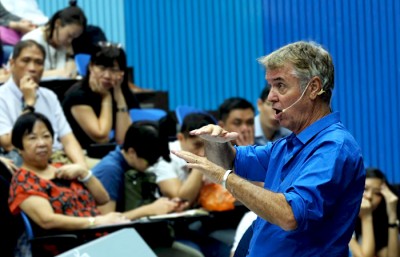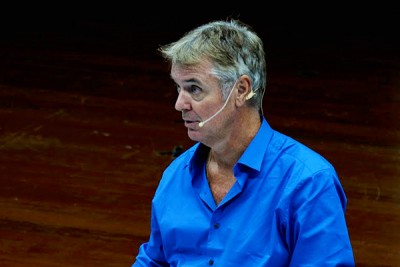Why Singapore’s English Teachers Should Embrace Singlish, Not Fight It
Is it time for Singaporean educators to embrace Singlish as a legitimate learning tool? What the Research […]
Read More
With over 1200 meta-studies done covering over 250 million students, Professor John Hattie knows that every effort a teacher makes has an impact on student success. But what does success actually look like, and what influences have the strongest positive impact? This article is based on his talk “The Politics of Distraction versus the Politics of Collaborative Action” at the Educational Research Association of Singapore Seminar on October 23, 2015.
The Number 1 on the list of influences that have the highest impact on student achievement is student expectations, which I think is very exciting. On the one hand, it’s good news. If I ask any student from the age of about 8 onwards, “What mark are you going to get on the next test?”, it’s going to end up very accurate. So why do you give tests? I challenge you, next time you give a test, ask the kids to put the mark they think they’re going to get up front – they are extremely accurate. Your job is to mess that up.
You have to remember that the kids set safe targets. For example, when you go golfing over the weekend, if someone asks what score you’re going to get, you’ll probably say, like last week but a bit better? That’s what students do. Your job is to say to the student who thinks they’re going to get a C grade that, look, I want you to set a target of a B grade, and I can help you, and from there, B to A, and A to A+. Raise their expectations and then help them reach these new standards.

(Photo courtesy of Educational Research Association of Singapore)
I’ve just published a piece of work which turns out to be quite unusual in this area, because no one’s really looked at this. We asked about 1000 adults to talk about their very best teachers, and we did the analysis in a very systematic way. Not one of those 1000 adults said that they liked their best teachers because of any content they taught.
Two things were common: (1) that teacher was important to me because they turned me on to their passion; or (2) that teacher was important because they saw something in me that I didn’t see myself. That’s it – that’s your job. Help find the hidden talents and raise the stakes.
Particularly in high school, we know from previous work by other researchers, that if you take time tomorrow to take a student from your school out of class time and talk to them for at least 15 minutes about what is their school experience across all their classes, that student will never, ever forget you; because virtually no one speaks for 15 minutes to a kid in high school unless they’re naughty. Be a success coach.
And that’s the question I ask each and every one of you: Who’s in charge of success in your school, and how do we raise student expectations? And of course, they need great teachers to make sure that they attain those high grades.
Another factor that surprises me but it comes out very high in our learning strategies research – is showing students right at the beginning what success looks like.
Some of your students will do what you tell them to do regardless, but the ones that will go on to be successful, particularly those from the age of 11 to 12 onwards, they want to know what success looks like as they commence various tasks.
I was a music teacher, and it’s not that hard to tell them that this is what a piece of music sounds like. It shouldn’t be that difficult for the Math, Physics or other subjects. We have worked with a lot of teachers and it can be quite a struggle to get them to articulate what success is meant to look like up front. Many claim that they cannot possibly know what success looks like until we get there?

(Photo courtesy of Educational Research Association of Singapore)
Are any of you still stuck on Candy Crush? I didn’t play Candy Crush even once, because I got so obsessed with Angry Birds I decided to miss the craze! So these games have worked out how to engage us in learning. They know exactly what your prior achievement is – your last score. They know the Goldilocks Principle of Challenge: not too hard, not too easy.
They also know something teachers don’t know – show up front what success looks like and don’t lower the criteria of success. Don’t say, at the end of a lesson, “Oh you did your best, that’s the best you can do”, because that is not what our kids will enjoy.
Then the games give you an incredible number of opportunities (sometimes too much) to practise, to hone your skills, to gain feedback, to learn, and what happens when you get there? They raise the criteria! What do we do when the kids get there? We tell them good, they’ve handed in their work, here’s their grade, the work’s over! That’s what we’ve got to change.
We’ve got to give the thrill back to the students – so that when they get that success, they have that thrill of getting to the next level of Candy Crush or Angry Birds. And the best way to get that thrill is to know up front what the processes, what the criteria of what their success looks like.
And there is feedback. I’ve spent a lot of research time trying to understand feedback because it’s probably the most powerful but also the most variable. I’ve learned that we shouldn’t talk about how much feedback to give, because 8-year-olds have learned to use selective listening in your classrooms! It is the receiving, not the giving that matters. We may think we’ve given it, but often it is not received. So how do you understand what students understand when you give them your feedback? Ask them.
When I ask students, I get the same answer from almost everyone from every country I go to: For students, feedback helps them understand where to go next. So I challenge you teachers, no matter how much you think you’re giving students feedback, if there’s no “where to next”, they’ll claim they never received any feedback.